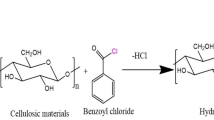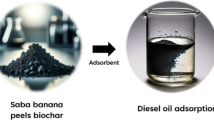Abstract
Oil spill leaves detrimental effects to environment, living organisms, and economy. As such, it is of considerable interest to find an effective, simple, and inexpensive method to treat this calamity. This work reports the use of banana trunk fibers (BTF) modified with oleic acid, stearic acid, castor oil, and palm oil for oil spill recovery. The maximum sorption capacity, effect of oil to water ratio, effect of light oil fractions, and effect of dissolved organic compounds in weathered oil-contaminated seawater were studied. It is found that BTF treated with oleic acid exhibited the best sorption capacity for engine oil, dissolved organic compounds in weathered oil, and light oil fractions. The equilibrium process was described well by the Freundlich isotherm model, and the kinetic studies show good correlation coefficients for a pseudo-second-order kinetic model.












Similar content being viewed by others
References
Ajmal, M., Khan, H. A., Ahmad, S., & Ahmad, A. (1998). Role of sawdust in the removal of copper (II) from industrial wastes. Water Research, 32, 3085–3091.
Annunciado, T. R., Sydenstricker, T. H. D., & Amico, S. C. (2005). Experimental investigation of various vegetable fibers as sorbent materials for oil spills. Marine Pollutant Bulletin, 50, 1340–1346.
Banerjee, S. S., Joshi, M. V., & Jayaram, R. V. (2006). Treatment of oil spill by sorption technique using fatty acid grafted sawdust. Chemosphere, 64, 1026–1031.
Bilba, K., Arsene, M. A., & Ouensanga, A. (2007). Study of banana and coconut fibers: botanical composition, thermal degradation and textural observations. Bioresource Technology, 98, 58–68.
Boopathy, R. (2000). Factors limiting bioremediation technologies. Bioresource Technology, 74, 63–67.
Christie, W. W. (1999). Preparation of ester derivatives of fatty acids for chromatographic analysis. In W. W. Christie (Ed.), Advances in lipid methodology (pp. 69–111). Invergowrie, Dundee, Scotland: The Scottish Crop Research Institute.
Choi, H., & Cloud, R. M. (1992). Natural sorbents in oil spill cleanup. Environmental Science and Technology, 26, 772–776.
Freundlich, H. M. F. (1906). Over the adsorption in solution. Journal of Physical Chemistry, 57, 385–470.
Gurgel, L. V. A., de Freitas, R. P., & Gil, L. F. (2008). Adsorption of Cu(II), Cd(II), and Pb(II) from aqueous single metal solutions by sugarcane bagasse and mercerized sugarcane bagasse chemically modified with succinic anhydride. Carbohydrate Polymer, 74, 922–929.
Hameed, B. H., Mahmoud, D. K., & Ahmad, A. L. (2008). Sorption equilibrium and kinetics of basic dye from aqueous solution using banana stalk waste. Journal of Hazardous Materials, 39, 338–343.
Ho, Y. S., & McKay, G. (1999). A kinetic study of dye sorption by biosorbent waste product pith. Resource, Conservation & Recycling, 25, 171–193.
Hondroulis, D. G., Ratowsky, I. P., Kingham, N. W., & Kingham, K. T. B. (2000). Process for sorbing liquids using tropical fibers. US Patent, 6(027), 652.
Jian, W., Kitanaka, A., Nishilima, W., Baes, A. U., & Okada, M. (1999). Removal of oil pollutants in seawater as pretreatment of reverse osmosis desalination process. Water Research, 33, 1857–1863.
Langmuir, I. (1918). The adsorption of gases on plane surfaces of glass, mica and platinum. Journal of American Chemical Society, 40, 1361–1403.
Lee, B. G., Han, J. S., & Rowell, R. M. (1999). Oil sorption by lignocellulosic fibers. In B.G. Lee (Ed.), Kenaf properties, processing and Products (pp. 423–433). Mississippi State University, Agriculture & BioEngineering, Starkville, MS.
Lim, T. T., & Huang, X. (2007). Evaluation of kapok (Ceiba pentandra (L.) Gaertn.) as a natural hollow hydrophobic–oleophilic fibrous sorbent for oil spill cleanup. Chemosphere, 66, 955–963.
Lodha, P., & Netravali, A. N. (2005). Characterization of stearic acid modified soy protein isolate resin and ramie fiber reinforced green composites. Composite Science & Technology, 65, 1211–1225.
Manual of Methods of Analysis of Food. Directorate General of Health Services Ministry of Health and Family Welfare Government Of India, New Delhi, 2005.
Markley, I. K. S. (1947). Fatty acid. New York: Interscience Publication.
Mas Hakim, M. R. H., & Kathiresan, S. (2009). The removal of methyl red from aqueous solutions using agricultural waste: banana pseudostem fibers. American Journal of Applied Sciences, 6, 1690–1700.
Payne, J. R., & Phillips, C. R. (1985). Photochemistry of petroleum in water. Environmental Science & Technology, 19, 569–579.
Shibi, I. G., & Anirudhan, T. S. (2002). Synthesis, characterization and application as a mercury(II) sorbent of banana stalk (Musa paradisiaca)-polyacrylamide grafted copolymer bearing carboxyl groups. Indian Engineering Chemical Research, 41, 5341–5342.
Shibi, I. G., & Anirudhan, T. S. (2005). Adsorption of Co(II) by a carboxylate functionalized polyacrylamide grafted lignocellulosics. Chemosphere, 58, 1117–1126.
Socrates, G. (1994). Infrared Characteristic Group Frequencies (second ed.), John Wiley & Sons, West Sussex, U.
Sugiura, K., Ishihara, M., Shimauchi, T. & Harayama, S. (1997). Physicochemical properties and biodegradability of crude oil. Environmental Science and Technology 31, 45–51.
Sun, R. C., Tomkinson, J., Ma, P. L., & Liang, S. F. (2000). Comparative study of hemicelluloses from rice straw by alkali and hydrogen peroxide treatments. Carbohydrate Polymer, 42, 111–122.
Tan, I. A. W., Hameed, B. H., & Ahmad, A. L. (2006). Equilibrium and kinetics studies on basic dye adsorption by oil palm fiber activated carbon. Chemical Engineering Journal, 127, 111–119.
Teas, Ch, Kalligeros, S., Zanikos, F., Stournas, S., Lois, E., & Anastopoulos, G. (2001). Investigation of the effectiveness of absorbent materials in oil spills clean up. Desalination, 140, 259–264.
Tempkin, M. J., & Pyzhev, V. (1940). Recent modifications to Langmuir isotherms. Acta Physicochimica, U.R.S.S, 12, 217–222.
Xu, F., Sun, J. X., Geng, Z. C., Liu, C. F., Ren, J. L., Sun, R. C., et al. (2006). Fractional and structural characterization of hemicelluloses from perennial ryegrass(Lolium perenne) and cocksfoot grass (Dactylis glomerata). Carbohydrate Polymer, 314, 2073–2082.
Yang, H., Yan, R., Chen, H., Lee, D. H., & Zheng, C. (2007). Characteristics of hemicellulose, cellulose and lignin pyrolysis. Fuel, 86, 1781–1788.
Acknowledgements
This study is partially funded by the Ministry of Science, Technology, and Innovation (MOSTI) of Malaysia. The authors are also grateful to the School of Chemical Sciences, Universiti Sains Malaysia, and the Faculty of Applied Sciences, AIMST University, for providing the facilities to carry out this research.
Author information
Authors and Affiliations
Corresponding author
Rights and permissions
About this article
Cite this article
Sathasivam, K., Mas Haris, M.R.H. Adsorption Kinetics and Capacity of Fatty Acid-Modified Banana Trunk Fibers for Oil in Water. Water Air Soil Pollut 213, 413–423 (2010). https://doi.org/10.1007/s11270-010-0395-z
Received:
Accepted:
Published:
Issue Date:
DOI: https://doi.org/10.1007/s11270-010-0395-z




